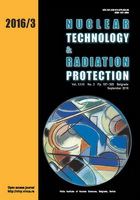
FACTORS INFLUENCING U(VI) ADSORPTION ONTO SOIL FROM A CANDIDATE VERY LOW LEVEL RADIOACTIVE WASTE DISPOSAL SITE IN CHINA

Vol.
XXXI, No. 3, Pp. 197-305
September 2016
UDC 621.039+614.876:504.06
ISSN 1451-3994
Pages: 268-276
Authors: Rui Zuo, Li Liu, Xiaoyan Jiang, Xin Guan, Yanguo Teng, Fei Ding, Jie Yang, and Jinsheng WangAbstract
The properties of soil at disposal sites are very important for geological disposal of very low level radioactive waste in terms of U(VI). In this study, soil from a candidate very low level radioactive waste disposal site in China was evaluated for its capacity on uranium sorption. Specifically, the equilibrium time, initial concentration, soil particle, pH, temperature, and carbonate were evaluated. The results indicated that after 15-20 days of sorption, the Kd value fluctuated and stabilized at 355-360 mL/g. The adsorptive capacity of uranium was increased as the initial uranium concentration increased, while it decreased as the soil particle size increased. The pH value played an important role in the U(VI) sorption onto soil, especially under alkaline conditions, and had a great effect on the sorption capacity of soil for uranium. Moreover, the presence of carbonate decreased the sorption of U(VI) onto soil because of the role of the strong complexation of carbonate with U(VI) in the groundwater. Overall, this study assessed the behavior of U(VI) sorption onto natural soil, which would be an important factor in the geological barrier of the repository, has contribution on mastering the characteristic of the adsorption of uranium in the particular soil media for the process of very low level radioactive waste disposal.
Key words: uranium, soil, adsorption, influencing factor, batch test, very low level radioactive waste
FULL PAPER IN PDF FORMAT (640 KB)